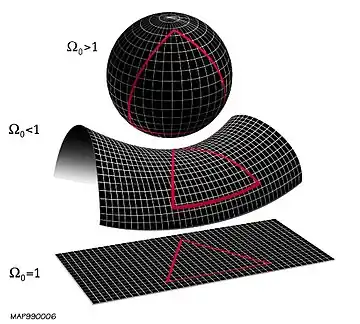
In geometry, an Hadamard space, named after Jacques Hadamard, is a non-linear generalization of a Hilbert space. In the literature they are also equivalently defined as complete CAT(0) spaces.
A Hadamard space is defined to be a nonempty[1] complete metric space such that, given any points and there exists a point such that for every point
The point is then the midpoint of and
In a Hilbert space, the above inequality is equality (with ), and in general an Hadamard space is said to be flat if the above inequality is equality. A flat Hadamard space is isomorphic to a closed convex subset of a Hilbert space. In particular, a normed space is an Hadamard space if and only if it is a Hilbert space.
The geometry of Hadamard spaces resembles that of Hilbert spaces, making it a natural setting for the study of rigidity theorems. In a Hadamard space, any two points can be joined by a unique geodesic between them; in particular, it is contractible. Quite generally, if is a bounded subset of a metric space, then the center of the closed ball of the minimum radius containing it is called the circumcenter of [2] Every bounded subset of a Hadamard space is contained in the smallest closed ball (which is the same as the closure of its convex hull). If is the group of isometries of a Hadamard space leaving invariant then fixes the circumcenter of (Bruhat–Tits fixed point theorem).
The basic result for a non-positively curved manifold is the Cartan–Hadamard theorem. The analog holds for a Hadamard space: a complete, connected metric space which is locally isometric to a Hadamard space has an Hadamard space as its universal cover. Its variant applies for non-positively curved orbifolds. (cf. Lurie.)
Examples of Hadamard spaces are Hilbert spaces, the Poincaré disc, complete real trees (for example, complete Bruhat–Tits building), -space with and and Hadamard manifolds, that is, complete simply-connected Riemannian manifolds of nonpositive sectional curvature. Important examples of Hadamard manifolds are simply connected nonpositively curved symmetric spaces.
Applications of Hadamard spaces are not restricted to geometry. In 1998, Dmitri Burago and Serge Ferleger[3] used CAT(0) geometry to solve a problem in dynamical billiards: in a gas of hard balls, is there a uniform bound on the number of collisions? The solution begins by constructing a configuration space for the dynamical system, obtained by joining together copies of corresponding billiard table, which turns out to be an Hadamard space.
See also
- CAT(k) space – Type of metric space in mathematics
- Hadamard manifold – complete, simply-connected Riemannian manifold with nonpositive sectional curvature everywhere
References
- ↑ The assumption on "nonempty" has meaning: a fixed point theorem often states the set of fixed point is an Hadamard space. The main content of such an assertion is that the set is nonempty.
- ↑ A Course in Metric Geometry, p. 334.
- ↑ Burago D., Ferleger S. Uniform estimates on the number of collisions in semi-dispersing billiards. Ann. of Math. 147 (1998), 695-708
- Bridson, Martin R.; Haefliger, André (1999), Metric spaces of non-positive curvature, Springer
- Papadopoulos, Athanase (2014), Metric spaces, convexity and non-positive curvature, IRMA Lectures in Mathematics and Theoretical Physics, vol. 6 (Second ed.), European Mathematical Society, ISBN 978-3-03719-132-3
- Burago, Dmitri; Yuri Burago, and Sergei Ivanov. A Course in Metric Geometry. American Mathematical Society. (1984)
- Jacob Lurie: Notes on the Theory of Hadamard Spaces
- Alexander S., Kapovich V., Petrunin A. Notes on Alexandrov Geometry